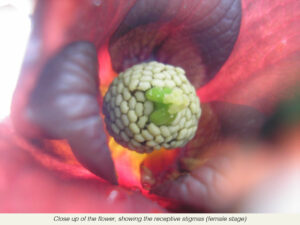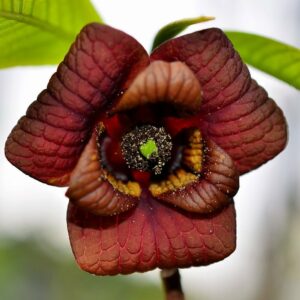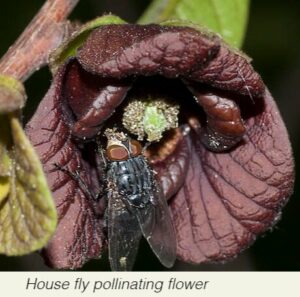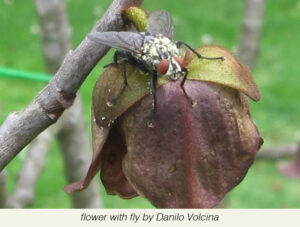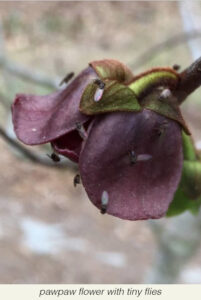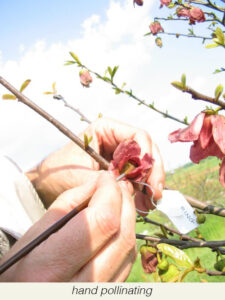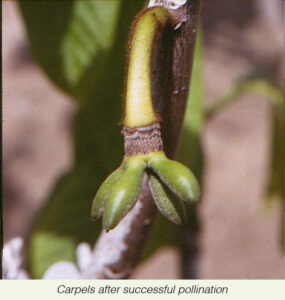Pollination
Fertilization
Pawpaw trees are self-infertile, although exceptions are possible. Therefore, for good fruit set each variety must be fertilized with pollen from a different variety of pawpaw tree. Pawpaw blossoms are purplish-red and have a fetid odor to attract their primary pollinators, various species of flies and beetles. Bees rarely, if ever, visit pawpaw flowers. If natural pollination is inadequate, you may wish to attract flies to your pawpaw trees.
Corwin Davis found that hanging road kill in his trees during blossom season worked well. Manure might work well. Neal never used attractants and still had good pollination. Pollination is weather dependent. Cold, rainy, breezy weather is not conducive to fly (or bee) activity and can result in low fruit set. Hand pollination of pawpaw is not difficult. For the backyard grower this is a feasible way to increase fruit set.
Protecting the Fruit
To protect the ripening fruit (usually about 2 weeks before maturity) I enclose the clusters in a mesh bag made from panty hose. I tie the cloth bag to the branch to hold the fruits firmly when they drop off the peduncle.
Crossing is a complex procedure. the first year I did remove petals and tried to enclose flower in a bag to exclude insects, but the entire procedure left me feeling that I was doing harm (indirectly) to the health of the pistils/ovules and fertilization (a probable release of ethylene from the damaged tissues). After that, I almost never have removed the anthers or petals. I also reason that the natural enclosure formed from the petals raises the humidity level around the stigma, keeping the fluid secretions moist, shading the stigma from direct sunlight, and probably promoting the health of pollen tube extension, etc.
Weather & Other Variables
Critical variables to pollination success are weather and time of day. For triloba it is important to have warm shirtsleeve weather with almost no breeze, with good soil moisture, such as a day after a rain. Morning does not seem to be as good a time to pollinate triloba as afternoon, even late afternoon.
Pollination Process
Pawpaw flowers begin as female with receptive stigma and then become male, releasing pollen. I spend a lot of time choosing the flowers to pollinate, inspecting numerous flowers in the early female stage, with a hand lens to scrutinize the stigmas. Are the stigmas plump, enlarged, feathery and/or glistening? Are they free of any visible sign of pollen deposition? Then I tag those flowers and with a very soft flexible small brush (it must be VERY flexible & soft) I coat the entire stigmas leaving no room for additional pollen. I reason that if the surface is totally coated than I do not need to exclude insect visitors.
POSTSCRIPT: my triloba flowers are at eye level and so this inspection isn’t arduous, but I can envision it may be physically demanding to inspect the flowers of the shrubby Asiminas.
In truth, I seldom put any cover over the pistils, although I know that in a peer reviewed article this lacuna would be severely criticized. But my results bear me out — not one seedling I have raised from my crosses has failed to show traits intermediate with the non-triloba parent, and I have raised over 500. But I do have a covering technique that is thorough and simple: I take the open end of a size XXX gelatin capsule, smear the capsule edge with Elmer’s glue, and slip this cap over the cluster of pistils. The glue adheres the cap to the ball of anthers, and then when the anthers are shed, the cap falls off.
My final technique is an elaboration of the tagging of the flowers. I found that merely tagging the peduncle meant that if the fertilization failed, the flower & peduncle fell from the tree and I was left searching the tree for a tag that wasn’t there. Therefore, I now loop the tag first around the branch and then around the peduncle. It is important (obviously) not to tie the tag in such a way as to inadvertently girdle the peduncle or branch. If the fertilization fails, then the dead flower is left hanging from the branch by the string of the tag.
Pollination Gallery
